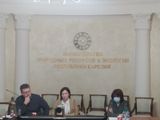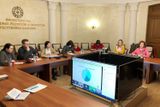Plenary session “Optimizing communal waste value chains” was moderated by Elena Vedentsova, the head of the Department of environmental protection and waste management of The Ministry of Natural Resources and Ecology of the Republic of Karelia.
Morten Hjort-Johansen from Grønt Punkt Norge gave the first presentation and told the audience of the way packaging, plastic in particular, is handled in Norway both on the household and business level. The presentation also covered the PR issue, the audience learnt about Grønt Punkt’s consumer campaigns and work with the population and businesses of Norway. The system of membership and fees producers and importers of packaging pay for its management was very well received on the Russian side and Morten Hjort-Johansen was asked numerous questions by both The Ministry of Natural Resources and Ecology of the Republic of Karelia and the regional waste management operator in Karelia, Autospetstrans LLC.
Sergey Faschevsky described the system for management of communal waste in Norwegian communities using the example of Tromsø. This presentation was focused on the responsibilities of people rather than businesses. The questions from the audience included the share of sorted and recyclable waste (30-40 %) and the attitude towards waste incineration in Norway. Great progress in waste sorting done by the population was noted compared to the start of the process in 1990s.
The round table for discussion on various elements on communal waste management and experience from Karelia, Komi Republic and Nordic countries was moderated by Sergey Faschevsky, senior advisor of Norsk Energi.
Tatyana Plato, the deputy head of Center of nature protected areas of the Komi Republic gave a detailed presentation of the steps taken in the Komi republic that were both large and small scale and described the assistance they received. Another topic was the environmental hot spots related to waste which is common for both Komi and Karelia, Tatyana Plato told the audience about monitoring, assessment and management of environmental hot spot Ko-6 as an example.
Tatyana Plato also presented the steps towards engagement of the population into waste management, awareness raising and training measures taken by Center of nature protected areas of the Komi Republic. A grant obtained from Cleaner Production and Sustainable Development Centre (Moscow) made it possible for them to procure and develop visual aids, games and series of campaigns aimed at influencing the attitude of the population towards waste sorting and recycling.
Ekaterina Vinogradova who in involved in volunteer environmental projects in Karelia and also works for the regional waste management operator Autospetstrans LLC and is involved in customer campaigns considers materials and means of consumer involvement developed and applied in the Komi Republic to be great.
Sveta Silvenoinen-Hisku representing the Ministry of the environment of Finland gave an overview of Separate waste collection in Finland. In Finland municipalities imposes tariffs on homeowners’ associations that depends on the number of containers they have for each type of waste and the frequency of waste removal. The citizens are directly motivated to produce less waste and sort it better to reduce their costs. Hazardous waste and waste that is hard to collect from households is transported to waste collection points by the citizens in Finland. There are such points for multiple types of waste outside populated areas and there are pick-up points for different types of waste within cities marked on a map assisting in waste sorting and recycling. The population actively uses this instrument.
Idar Bergfjord from Norsk Energi gave a number of video presentations on waste handling in Norway. One of the videos showed waste sorting at home, Idar having several trash bins and throwing away different types of waste into different bins, then utilizing separate outside waste cans. Similar to Finland, Norway has waste collection points for hazardous or specialized waste that are free to use for any citizen.
Another video by Norsk Energy showed how a waste management company ROAF works in their medium-sized municipality (about 500 000 people). A video demonstrated all stages of ROAF operation, starting from how waste is sorted by households and up to the moment it is processed by the company.
The audience found the seminar informative and useful from a practical point of view, and several questions arose that still have to be answered. For that the third seminar is planned for early 2022, that will focus on lowering the amount of waste generated, the issues of composting and the use of biogas, as well as best available technologies in communal waste management.

